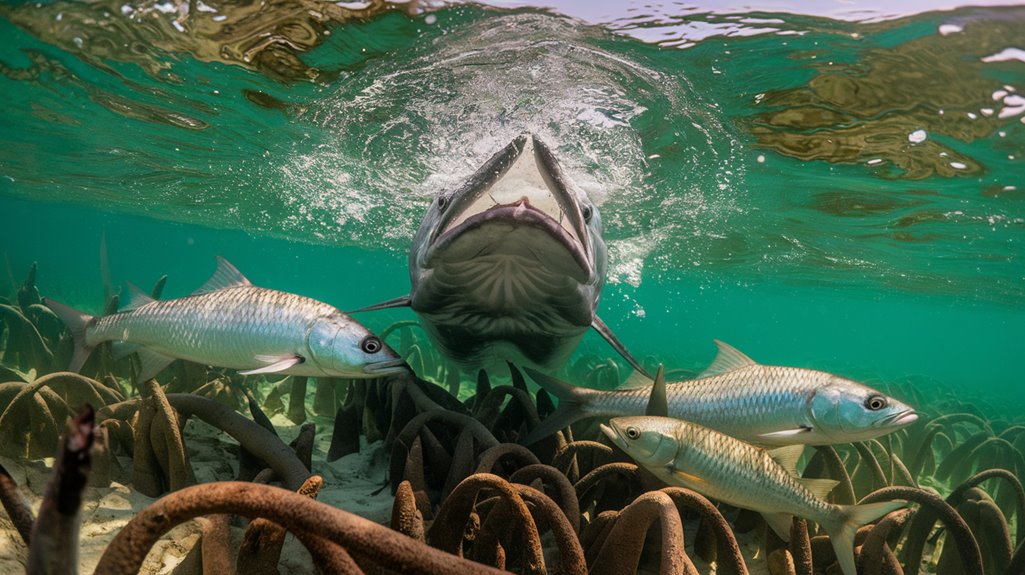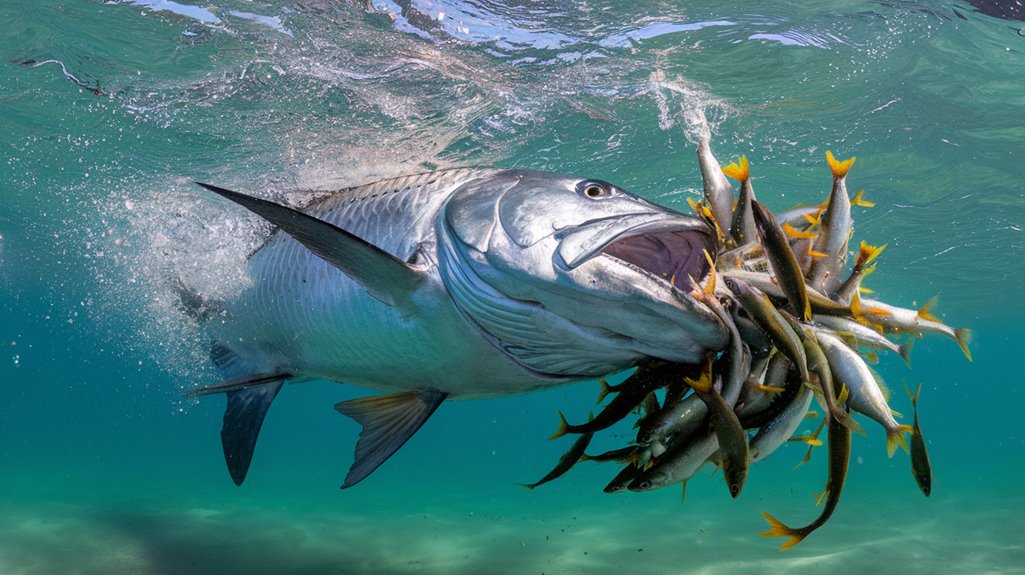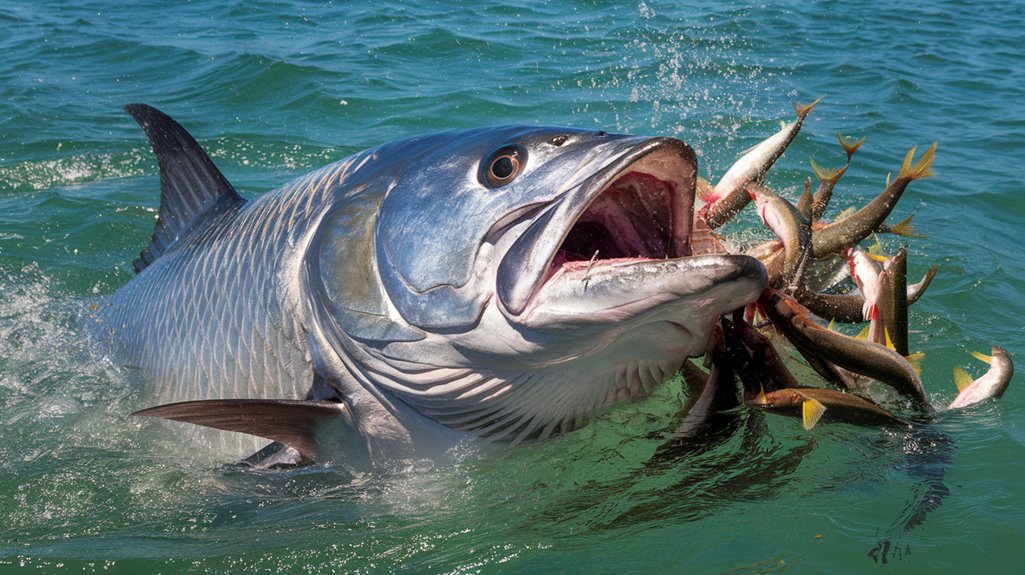You'll discover that tarpon's feeding behaviors follow distinct patterns throughout their life cycles, adapting to both environmental conditions and physical capabilities. As these prehistoric fish grow from juveniles to adults, their prey selection shifts dramatically – from microscopic organisms to substantial fish species. The intricate relationship between water temperature, prey availability, and hunting success reveals nature's precise calibration of predator-prey dynamics, setting the stage for a deeper exploration of these remarkable adaptations.
Key Takeaways
- Tarpon feeding activity peaks at 28°C, with juveniles primarily consuming copepods and larger individuals targeting crustaceans and small fish.
- Temperature significantly influences feeding patterns, with reduced activity below 25°C and increased empty stomachs during cooler months.
- Juvenile tarpon use surface-water ambush tactics with upward-facing mouths to capture prey while remaining motionless.
- Diet composition evolves with size, transitioning from copepods in small tarpon to more diverse prey options in larger specimens.
- Environmental factors, including dissolved oxygen levels and habitat quality, directly impact tarpon feeding success and prey availability.
Foraging Patterns Across Life Stages

As tarpon progress through different life stages, their foraging patterns undergo distinct changes that reflect their changing nutritional needs and physical capabilities. You'll find that age-0 tarpon initially focus on consuming small prey like copepods, but as they grow beyond 100 mm, their diet composition expands to include larger crustaceans and small fish. This size-related shift in feeding behavior demonstrates the species' adaptive foraging patterns.
Juvenile tarpon show a clear progression in their prey taxa selection, with smaller individuals displaying limited dietary variety compared to their larger counterparts. You'll notice these feeding dynamics are particularly evident in coastal nursery habitats, where salt marshes provide essential food resources. Water temperature greatly influences their foraging success, with ideal feeding occurring around 28°C and reduced activity below 25°C.
Prey Selection and Hunting Techniques
Tarpon's hunting techniques primarily rely on their signature gulping method, where you'll observe them utilizing surface-water ambush tactics to efficiently capture fish and crustaceans. You'll notice their prey selection evolves with size, as juveniles target smaller organisms like copepods before shifting to larger prey as they grow. Their hunting patterns show clear seasonal variations tied to water temperature, with peak feeding activity occurring at 28°C when you'll find them most actively pursuing their prey.
Ambush Tactics While Feeding
While lurking near the water's surface, tarpons demonstrate remarkable efficiency in their ambush-based hunting strategy. You'll observe their distinctive feeding behavior as they remain motionless, utilizing their upward-facing mouths to swiftly capture unsuspecting prey. Their surface positioning enables ideal prey selection, particularly when targeting schools of smaller fish and crustaceans within striking distance.
You'll notice their opportunistic feeding patterns adapt to available food resources, with increased success rates in warmer water temperatures above 25°C. Their hunting technique often incorporates impressive aerial displays, which serve to disorient nearby fish. This combination of ambush technique and strategic positioning makes tarpons highly effective predators, as they've evolved to maximize their hunting success through careful timing and precise movements in their aquatic environment.
Size-Based Prey Targeting
Through their developmental stages, tarpon exhibit distinct size-dependent prey preferences that directly influence their hunting success. You'll find that age-0 tarpon demonstrate clear size-based prey targeting, with individuals under 100mm primarily consuming copepods, while larger specimens shift to more substantial prey like crustaceans and small fish. Their dietary composition evolves considerably, as smaller tarpon focus on fewer prey taxa compared to their larger counterparts.
Water temperature plays an essential role in feeding patterns, with ideal prey consumption occurring around 28°C. Juvenile tarpon's adaptability in prey selection enables them to thrive across various habitats, utilizing their distinctive gulping method with upward-facing mouths to capture prey effectively near the surface. This strategic approach to feeding guarantees successful growth and survival across different size classes.
Seasonal Diet Adaptations
According to seasonal changes in water temperature, tarpon demonstrate remarkable adaptations in their feeding patterns and prey selection. You'll observe their opportunistic predation shift from smaller prey to larger ones as temperatures rise above 25°C, with age-0 tarpon targeting copepods during cooler months and evolving to larger crustaceans in warmer waters.
| Temperature (°C) | Primary Prey | Feeding Activity |
|---|---|---|
| ≤25 | Copepods | Low |
| 25-28 | Small Crustaceans | Moderate |
| 28 | Mixed Prey | Peak |
| >28 | Large Crustaceans | High |
Their feeding behavior achieves peak efficiency at 28°C, where you'll find the highest proportion of tarpon with prey in their stomachs. This seasonal dietary adaptation showcases their ability to modify hunting techniques and maximize foraging success across varying environmental conditions.
Environmental Influences on Feeding Behavior
You'll find that water temperature greatly impacts tarpon feeding behavior, with ideal foraging occurring around 28°C and reduced feeding activity at temperatures below 25°C. Seasonal shifts in prey availability directly affect tarpon's dietary patterns, as smaller juveniles target copepods while larger individuals adapt to consuming bigger crustaceans and fish. These feeding patterns are further influenced by dissolved oxygen levels in coastal nursery habitats, which can determine both prey distribution and the tarpon's ability to actively hunt.
Temperature Effects On Feeding
Water temperature plays an essential role in regulating tarpon feeding behavior, particularly among age-0 juveniles. You'll find that these fish demonstrate peak feeding activity at 28°C, where they're most likely to have prey in their stomachs. When temperatures drop below 25°C, you'll notice a significant decline in feeding success.
| Temperature (°C) | Feeding Activity | Primary Prey |
|---|---|---|
| ≤25 | Low | Empty stomachs |
| 28 | Ideal | Most active |
| >28 | Declining | Less active |
| Variable | Size ≤100mm | Copepods |
| Variable | Size >100mm | Lg. Crustaceans |
The temperature effects extend beyond simple feeding rates, as they influence dietary preferences based on size. You'll observe smaller juveniles (≤100 mm) targeting copepods, while larger ones shift to bigger crustaceans, highlighting the critical role of nursery habitat temperatures in supporting growth and recruitment.
Dissolved Oxygen Impact
Since juvenile tarpon rely on both dissolved oxygen and air breathing for survival, their feeding patterns exhibit a complex relationship with oxygen availability in their environment. You'll notice that when dissolved oxygen levels drop, juvenile tarpon must surface more frequently to gulp air, which greatly impacts their feeding behavior. This increased need for surface breathing directly correlates with reduced feeding activity and more empty stomachs. The ideal temperature of 28°C creates favorable conditions by maintaining higher dissolved oxygen concentrations, which enhances prey availability. Understanding these relationships is vital for maintaining healthy aquatic environments that support juvenile tarpon populations. As you monitor these fish, you'll observe how their feeding success depends heavily on the delicate balance of dissolved oxygen in their habitat.
Seasonal Prey Availability
Seasonal variations dramatically shape the feeding patterns of juvenile tarpon, with temperature playing a central role in prey availability and consumption rates. You'll find that age-0 tarpon exhibit peak feeding activity at water temperatures around 28°C, where their stomachs contain the highest proportion of prey items.
You can observe distinct dietary shifts as these fish grow, with smaller age-0 tarpon (≤100 mm) primarily consuming copepods, while larger individuals shift to crustaceans like shrimp as temperatures rise. In coastal nursery habitats, feeding activity significantly decreases when temperatures drop below 25°C, resulting in more empty stomachs. The seasonal changes don't just affect prey availability; they influence metabolic rates and the diversity of accessible food sources, directly impacting the growth and survival of juvenile tarpon.
Seasonal Dietary Variations
Throughout the year, tarpon exhibit distinct shifts in their feeding patterns that correlate strongly with environmental temperature changes and prey availability.
You'll find that water temperature plays an essential role in their feeding habits, with ideal feeding occurring around 28°C. At temperatures above 25°C, you're more likely to observe tarpon with full stomachs, actively consuming larger crustaceans and fish. However, when temperatures drop below 25°C, you'll notice an increase in empty stomachs, indicating reduced feeding activity.
The diet composition varies considerably with size. Age-0 tarpon measuring ≤100 mm primarily feed on copepods, while those exceeding 100 mm expand their diet to include a broader range of prey items. This seasonal variation in feeding habits demonstrates how tarpon adapt their dietary preferences to maximize feeding success across changing environmental conditions.
Feeding Adaptations and Survival Strategies

Tarpon possess remarkable physiological and behavioral adaptations that enhance their survival across diverse aquatic environments. You'll find their specialized upturned mouth and swim bladder are key feeding adaptations that allow them to thrive as opportunistic predators. Their swim bladder's unique function as a respiratory organ lets them extract oxygen from air, enabling survival in oxygen-poor waters.
Their diet and prey selection evolve with age, shifting from copepods to larger prey as they grow. Water temperature greatly influences their feeding success, with ideal prey capture occurring above 25°C. You'll notice their survival strategies extend beyond natural habitats, as they've adapted to anthropogenically-modified environments. This flexibility in feeding behavior and habitat utilization helps them maintain population stability despite environmental changes.
Impact of Habitat Changes on Food Sources
When natural marshes undergo transformation into anthropogenically-modified environments, you'll observe significant shifts in prey availability for juvenile tarpon. These habitat changes directly influence the diversity and abundance of prey organisms these fish can access.
You'll find that juvenile tarpon demonstrate remarkable dietary flexibility, enabling them to adapt to both mosquito control impoundments and restored marsh habitats. Research shows that age-0 tarpon modify their feeding patterns based on available food sources in these altered environments. This adaptability becomes crucial ecological knowledge as coastal wetlands face increasing degradation.
You'll note that habitat restoration efforts play an essential role in enhancing food availability for these fish. By improving habitat conditions, you're supporting important prey populations and strengthening juvenile tarpon recruitment in human-impacted ecosystems.
Frequently Asked Questions
What Is the Feeding Behavior of a Tarpon?
You'll find tarpon's feeding behavior centers on gulping fish and crustaceans with their large, upward-facing mouths, while adapting to temperature changes and tidal movements for ideal prey capture.
What Is a Tarpons Favorite Food?
You'll find that tarpons prefer copepods when young, then shift to larger prey as they grow, with shrimp and small fish becoming their primary food choices at ideal temperatures around 28°C.
Why Do We Not Eat Tarpon?
You won't find tarpon on menus because they have tough, unpalatable flesh, difficult-to-fillet bony structure, and can accumulate environmental toxins. They're valued more as sport fish than food.
How Old Is a 100 Pound Tarpon?
You'll find that a 100-pound tarpon is typically 10 to 15 years old, though exact age varies based on environmental conditions, habitat quality, and individual growth patterns.
Conclusion
As you've learned, tarpon's feeding habits exhibit remarkable plasticity across life stages and environmental conditions. You'll notice that temperature considerably influences their foraging success, with peak activity at 28°C. Your understanding of these dietary adaptations, from copepod consumption in juveniles to larger prey selection in adults, demonstrates how habitat preservation directly impacts tarpon populations through food web dynamics and resource availability.

